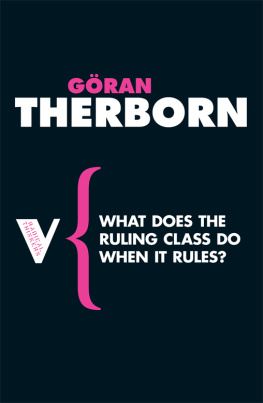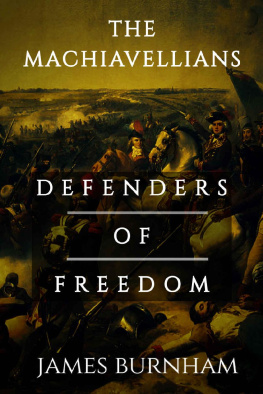Gaetano Mosca - The Ruling Class
Here you can read online Gaetano Mosca - The Ruling Class full text of the book (entire story) in english for free. Download pdf and epub, get meaning, cover and reviews about this ebook. year: 1939, publisher: McGraw Hill Book Company, Inc., genre: Politics. Description of the work, (preface) as well as reviews are available. Best literature library LitArk.com created for fans of good reading and offers a wide selection of genres:
Romance novel
Science fiction
Adventure
Detective
Science
History
Home and family
Prose
Art
Politics
Computer
Non-fiction
Religion
Business
Children
Humor
Choose a favorite category and find really read worthwhile books. Enjoy immersion in the world of imagination, feel the emotions of the characters or learn something new for yourself, make an fascinating discovery.

- Book:The Ruling Class
- Author:
- Publisher:McGraw Hill Book Company, Inc.
- Genre:
- Year:1939
- Rating:4 / 5
- Favourites:Add to favourites
- Your mark:
- 80
- 1
- 2
- 3
- 4
- 5
The Ruling Class: summary, description and annotation
We offer to read an annotation, description, summary or preface (depends on what the author of the book "The Ruling Class" wrote himself). If you haven't found the necessary information about the book — write in the comments, we will try to find it.
The Ruling Class — read online for free the complete book (whole text) full work
Below is the text of the book, divided by pages. System saving the place of the last page read, allows you to conveniently read the book "The Ruling Class" online for free, without having to search again every time where you left off. Put a bookmark, and you can go to the page where you finished reading at any time.
Font size:
Interval:
Bookmark:
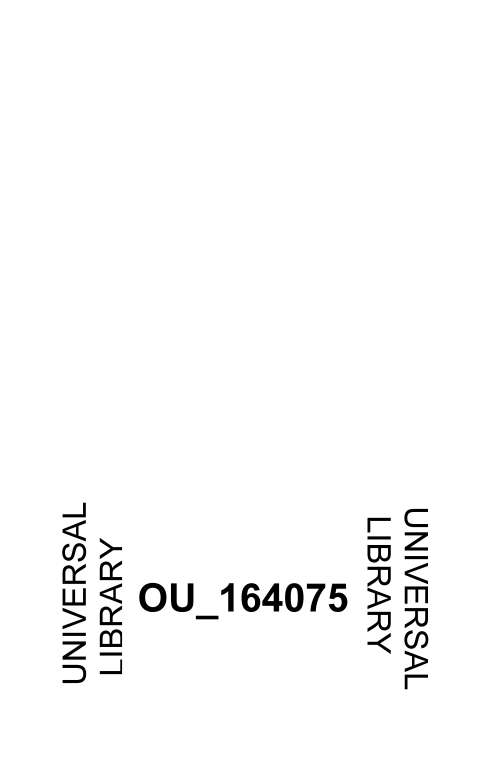

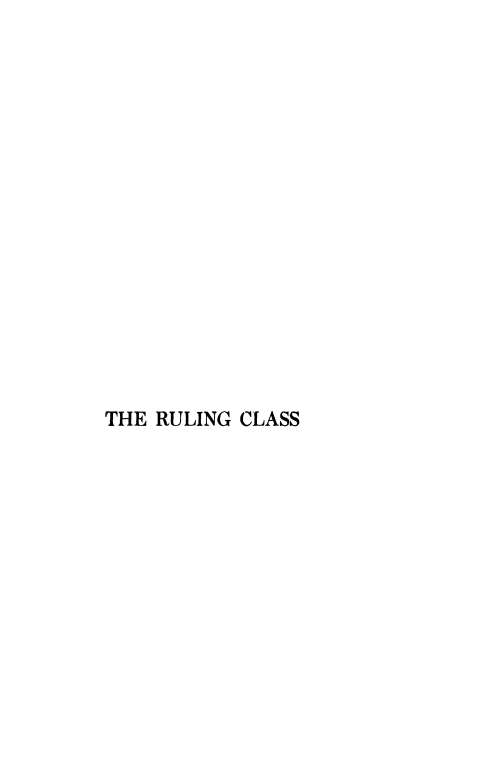
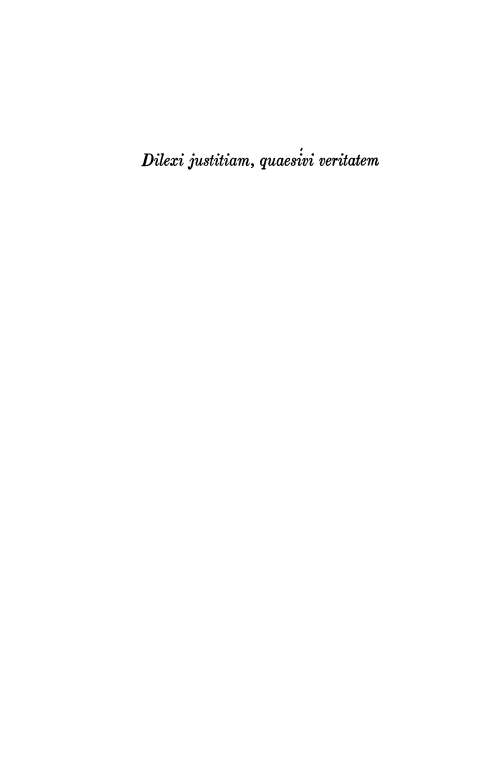
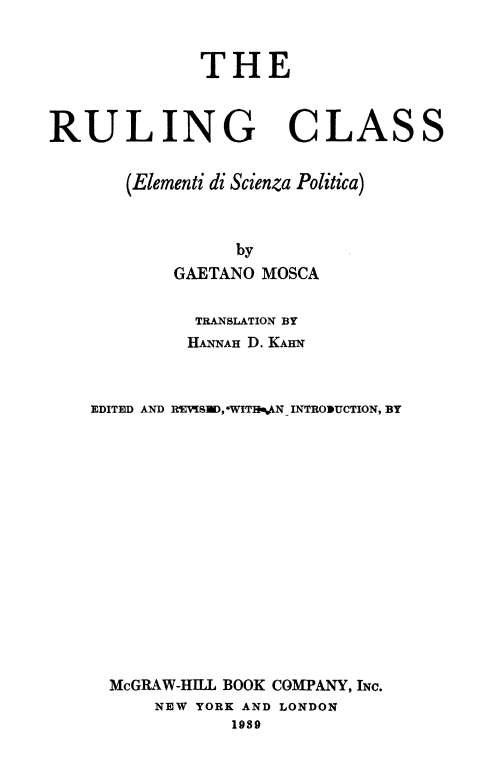
COPYRIGHT, 1989, BY THE MCGRAW-HILL BOOK COMPANY, INC.
*BINTBD IN THE UNITED STATES OF AMERICA
Att rights reserved. This book, or
parts thereof, may not be reproduced
in any form without permission of
the publishers.
CONTENTS
PAGE
INTKODUCTION ix
CHAPTEB
I. POLITICAL SCIENCE 1
Political science, 1-2.The experimental method and its limitations, 3.Science and political science, 4.Environmental theories; climate, 5.North and South theories, 6-8,Mountain and plain, 9.Eacial theories; the struggle for existence, 10.The concept of race; superior and inferior races, 11.Race and social type, 12.Evolutionary theories: the struggle for preeminence vs. the struggle for existence, 13.Evolution and progress, 14-15. The historical method, 16-20.
v ll. THE RULING CLASS 50
The concept of the ruling class, 1.Ruling class and the classification of governments, 2.The organized minority and the unorganized majority, 3.Political forces: Military valor: serfdom in Poland, 4.Wealth, 5.Religion and learning, 6.Hereditary tendencies in ruling classes, 7.Stability and rejuvenation of ruling classes, 8.
III. FEUDAL AND BUREAUCRATIC SYSTEMS (including Elementi, Chap.
VI, 5-8) 70
The political formula, 1.Social type, 2.Religion and social type, 3-5,The feudal type of political organization, 6.*^The bureaucratic state, 7-8.~ :Comte's classification: the three stages, 9-11.Spencer's classification: militant and industrial states, 11-12.
IV. RULING CLASS AND SOCIAL TYPE 108
Social type and expansion, 1.Ruling class and mixtures of social types, 2.Unity of social type and class differentiation, 3-4. Lower classes and social type, 5.Class isolation and social type* 6.
V. JURIDICAL DEFENSE 120
The moral sense and evolution, 1-2.Mechanisms for moral discipline, 3.Religion and morals, 4.Law and morals: juridical defense and type of political organization, 5.Despotisms and absolute principles, 6.Balance of social forces, 7.Separation of church and state, 8.Distribution of wealth and middle class, 9.
CHAPTER PAGE
Organization and representation of social forces, 10.Tendencies toward self-assertion of social forces: the United States, 11.
VR SUFFRAGE AND SOCIAL FORCES ....*? 158
Democratic theory: majority rule, 1.Majority and minority in the representative system, 2.Government control of economic production, 8.The concept of state, 4. (For Elementi, Chap. VI, 5-8, see Chap. Ill above.)
Vll. CHURCHES, PARTIES, AND SECTS 163
Groups and the struggle instinct, 1.Sectarian tendencies in human groupings, 2.Traits of prophets and founders, 3.The growth of religions and sects, 4.Doctrines and social environment, 5. The appeal of doctrines to sentiments good and bad, 6.Religion and realities: Christianity, Mohammedanism, 7.Choices of faiths: mimetism, 8.The Church and worldliness, 9.Persecution and mass control, 10.The arts of propaganda, 11.Struggle and social type: Is permanent peace desirable? 12.
VIII. REVOLUTION 199
Hellenic and medieval revolutions, 1.Roman, feudal, and Mohammedan revolutions, 2.Revolutions in China, 3.National uprisings and wars of independence, 4.Peasant rebellions and their leaders, 5.Modern French revolutions and over-bureaucratization, 6.Secret societies, revolutionary traditions, 7.
C"
IX. STANDING ARMIES 222
Military power in primitive societies, 1.Mercenaries and feudal societies, 2.Mercenary tyrannies, 3.Rise of standing armies, 4.Citizen militias, 5.Social distinctions: officers and privates, 6.Race and military valor, 7.Standing armies and juridical defense, 8.
X. PARLIAMENTARISM 244
Ruling class and the problems of modern society, 1.^The future of religion, 2-4.The crisis of democracy, 5.Evils of parliamentary systems and types of criticism, 6.Reform of parliamentary systems: "constitutional" reform, 7.Decentralization and middle class, 8.
XL COLLECTIVISM (Elementi, Chap. X, 9-19) .. 271
Ancient socialism; Rousseau and the rise of socialism in Europe, 1. Collectivism and faith in social betterment, 2.Ruling class under collectivism, 3.Absolute justice and social living, 4.Anarchism, 5.The class struggle, 6.Socialism and the abolition of poverty, 7.Causes of the growth of socialism, 8,Prospects of socialism, 9.Socialism and State control: Christian socialism, 10.Socialism and equality, 11.
CHAPTKB PAGE
XII. THEOBY OP THE RULING CLASS (Elementi, Part II, Chap. I) .... 329
History of the concept of ruling class, 1.Hilling class theory and democratic bias, 2.The concept of ruling class and scientific method, 3.
XIII. TYPES OF POLITICAL ORGANIZATION (Elementi, Part II, Chap. II), . 338 Primitive monarchies, 1.The Near-Eastern empire, 2.The Greek city-state, 3.Its weaknesses and limitations, $4.
XIV. EVOLUTION OF POLITICAL ORGANIZATION (Elementi, Part II, Chap.
Ill) 860
The Roman city-state, and the concept of citizenship, 1.Rise of Roman bureaucracy and standing army: the Empire, 2.Decline of Roman middle class and fall of the Empire, 3.The barbarian kingdoms and feudalism, 4.Rise of the national absolutisms, 5. Middle class and representative system, 6.The English constitution as a model for the Continent, 7.The representative system and level of civilization: structural weaknesses of the representative . system, 8.
XV. PRINCIPLES AND TENDENCIES IN RULING CLASSES (Elementi, Part
II, Chap. IV) 394
Autocratic and liberal principles, aristocratic and democratic tendencies, 1.Autocratic systems, 2.Ruling class and autocracy, 3.Liberal systems, 4.The democratic tendency and replenishment of ruling class, 5.The aristocratic tendency and social fossili-zation, 6.Balance of principles and tendencies, 7.
XVI. RULING CLASS AND INDIVIDUAL (Elementi, Part II, Chap. V) ... 430 Rulers and ruling class, 1.Ruling class and the governed; foreign dominations, 2.Historical materialism, the economic interpretation of history, 3.Government by the best, 4.Absolute justice and relative justice, 5.Science and social movement, 6.
XVII. FUTURE OF REPRESENTATIVE GOVERNMENT (Elementi, Part II,
Chap. VI) 465
The nineteenth century as an historical period, 1.Liberty, equality, fraternity, and their application, 2.Democracy and level of civilization, 3.Germs of decay in the representative system, 4.Alternatives to the representative system: dictatorship of the proletariat, bureaucratic absolutism, syndicalism, 5.Restoration of the representative system in Europe, 6.
INDEX AND BIBLIOGRAPHY 495
INTRODUCTION
I. Taine and Mosca: the Teorica.IL The Concept of History.III. Social Forces and Balance of Social Forces.IV. Juridical Defense: the importance of Political Organization.V. Standing Armies.VI. Social Type and Political Formula.VII. Level of Civilization.VIII. Democracy and Representative System.IX. Mosca and Pareto.X. On Translating Mosca.
I. TAINE AND MOSCA: THE Teorica
Gaetano Mosca's theory of the ruling class was evolved in its first form during the years 1878-1881, while Mosca was a* student under Angelo Messedaglia atUie iJiiiversity of Palermo. It occurred to him at that time to generalize the method which Taine had used in the Ancien regime. There, it will be remembered, Taine sought the origins of the French Revolution in the decadence of the groups of people that had ruled France during the golden age of the old monarchy, a class which he considered and analyzed under three headings, the crown, the clergy and the nobility.
Font size:
Interval:
Bookmark:
Similar books «The Ruling Class»
Look at similar books to The Ruling Class. We have selected literature similar in name and meaning in the hope of providing readers with more options to find new, interesting, not yet read works.
Discussion, reviews of the book The Ruling Class and just readers' own opinions. Leave your comments, write what you think about the work, its meaning or the main characters. Specify what exactly you liked and what you didn't like, and why you think so.

